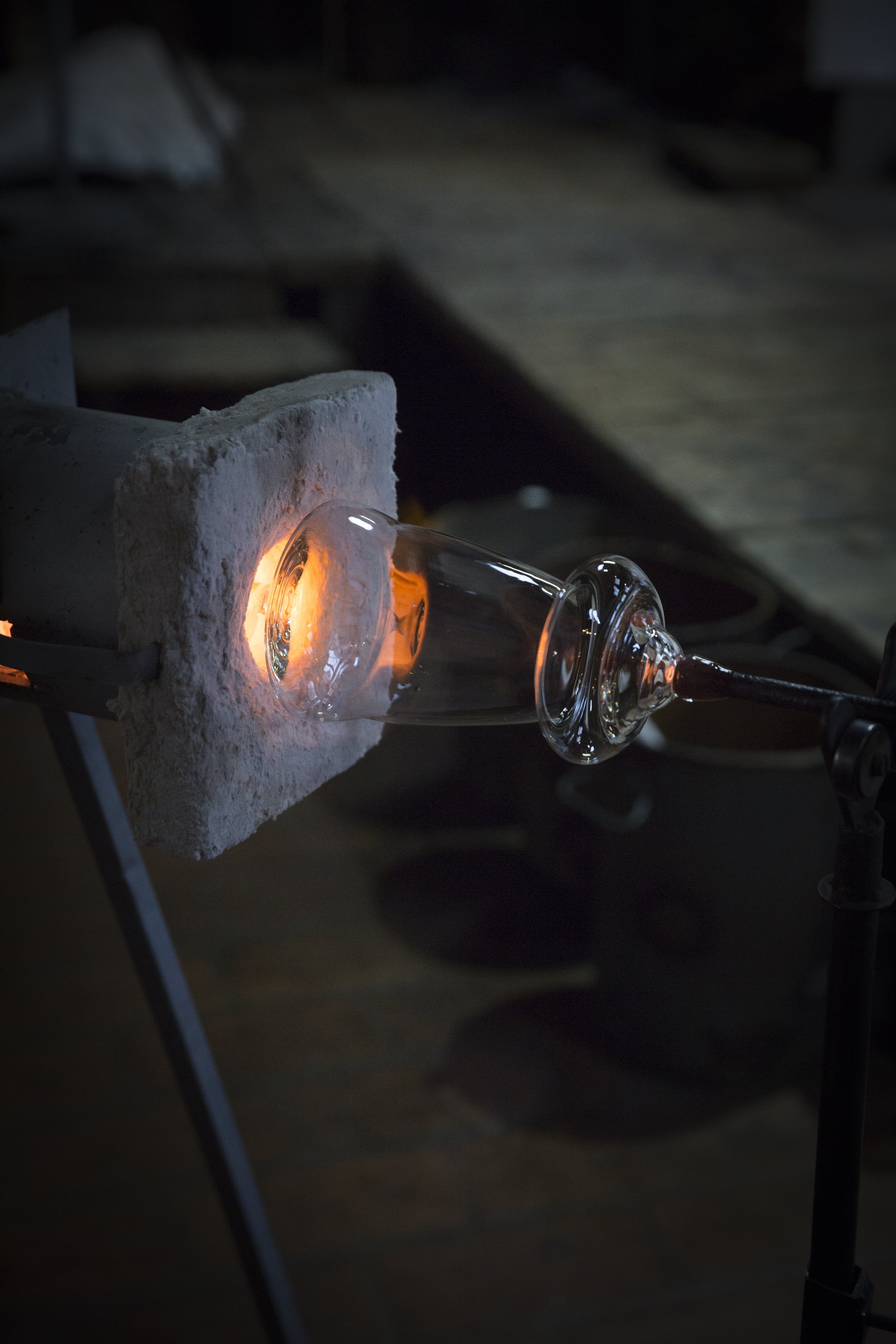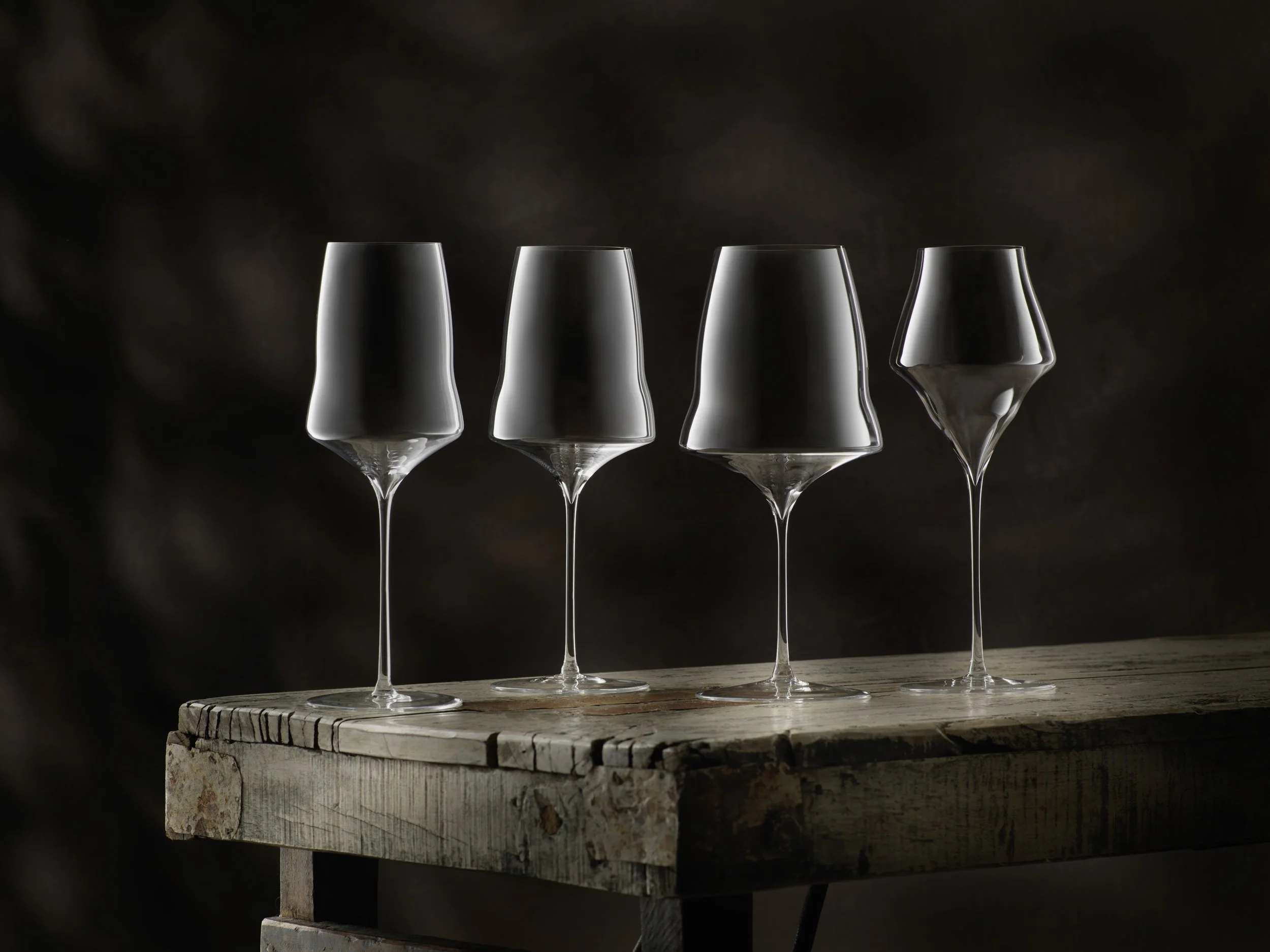Does The Shape Of Your Wine Glass *Actually* Matter?
6th generation Austrian glass designer, Kurt Josef Zalto, breaks down the ins and outs of tailored glassware.
Written by Eliza Dumais
Josephinenhütte co-founder Kurt Josef Zalto and CEO Marcus Meyer. Photo courtesy of Josephinenhütte.
The evolution of wine industry trends can often be traced in glassware: Fishbowl goblets, stemless glasses, stubby bistro-style vessels, the list goes on. Considering the hype, however — and the de rigeur glassware you’re seeing at every restaurant named on the year’s Top 10 lists — we’d be remiss not to ask: Does it actually matter? Do the nuances in a glasses’ shape actually impact our drinking experiences…at least for those of us not blessed with Master Sommelier palates?
In the name of research, we sat down with 6th-generation glassmaker Kurt Josef Zalto— Zalto’s former co-founder, designer, and managing director; and as of 2019, founding partner and chief designer at Josephinenhütte—to discuss the ins and outs of tailored glassware and the legacy of Austrian craftsmanship. “My passion for the art of glassmaking has been with me throughout my life. As a child, I often spent time in my father’s glasswork studios, so I quickly learned how the design of a wine glass played a vital role in enhancing the wine-drinking experience,” he says.
So, courtesy of the master himself, here’s what you need to (or want to) know:
How important is glassware to properly enjoying a wine?
Kurt Zalto: The shape of a glass significantly influences both the aroma and flavor of the wine. It’s essential to understand that our glasses go far beyond aesthetics. Through numerous blind tastings, and by witnessing the astonishment on people’s faces when they realize they’ve tasted the same wine from two different glasses—rather than two different wines—we’ve come to appreciate how much of a difference the glass truly makes.








What basic information do people need to know about glass shape when selecting their own glassware?
Kurt Zalto: There are a few key factors: First, the shape plays a vital role in developing aromas. Glasses with wider bowls allow more air to circulate, helping to release and intensify the wine’s bouquet, making the aromas more vivid. Second, the shape also influences how the wine’s perceived texture and flavors are delivered to the palate. And third, the quality of the materials is certainly a go-to consideration.
The style of wine, particularly its composition and characteristics, should determine your choice of glass. Using the appropriate glass enhances the characteristics of each different style of wine, ensuring that you can experience their full range of aromas and flavors. In general, complex wines with high concentration, great finesse, and structure — often red wines — usually benefit from larger bowls that promote aeration in order to showcase their unique energy. On the other hand, medium complex, fruit driven white wines are typically served in narrower glasses, such as the No. 1 JOSEPHINE wine glass, to help maintain their chill and focus on their primary fruity aromas.
A deep bowl, accentuates the delicate mousseux of nuanced Champagnes and the perlage of other sparkling wines. The shortened aroma chimney, in contrast to the moer universal glass glass shape, and the pronounced narrowing at the rim intensify the bouquet, guiding the aromas directly to the nose. Even sweeter wines, such as Spätlese or Auslese, can benefit from this shape.
Drinking highly complex, oaked white wine from a wider glass (the No. 3) can significantly enhance your tasting experience because the broader bowl allows more oxygen to interact with the wine, promoting the development of complex aromatic compounds and leading to a more nuanced tasting experience. Conversely, drinking red wine from a thinner, narrower glass might limit its aeration.
What is it about the JOSEPHINE glasses, specifically, that makes them more functionally impressive than other glasses?
Kurt Zalto: Wine truly tastes different from a JOSEPHINE glass, whether you’re a wine professional or someone who just occasionally enjoys wine. I’ve spent decades perfecting this glass—one that feels so natural, it’s as if it were shaped by nature, itself. A glass that releases the full potential of a wine’s flavors better than any other — through both tradition and innovation. Each glass features an exquisitely thin, almost ethereal design with a precisely-crafted bend that acts like a breakwater when swirling, allowing the wine to take in more oxygen and develop its aroma fully. At the same time, I like to say that the glass is so delicate that it feels as though you’re holding the wine itself in your hand.
What does your product design & execution process for JOSEPHINE look like?
Kurt Zalto: The beginning of the JOSEPHINE product building process is mostly rooted in my personal, never-ending quest for perfection. I am constantly fueled by an unshakeable passion for the art of glassmaking and a strong dedication to creating glassware that heightens the pleasure of enjoying wine.
A particularly important part of product realization is the special way our products are manufactured: Making mouth-blown glass is a lengthy process that requires great skill and experience on the part of the glassblower. Firstly, the glass is mixed with its various ingredients - I have a special mixture made for the Josephinenhütte. Then comes the melting process, where the furnace and the glass mixture are heated and cooled to ensure that there are no bubbles or impurities.
While constantly turning the blowpipe, the glassmaker skillfully blows the hot, liquid glass into the two-part beechwood mold. This creates the fine, wafer-thin goblet (the bowl) of the wine glass. The stem is then pulled out of the goblet with tongs and a liquid glass mass is applied, from which the base plate is rotated using special wooden tongs. The glass then goes back into a slightly heated oven so that it can cool down very slowly.
The next day, the finishing of the glass begins. The blasting of the top of the dome, the grinding of the rim and, of course, the polishing of the glass — and all of this is done entirely by hand. Any glass that does not meet the highest precision requirements and the defined feather-light weight is melted down again and recycled. Depending on the furnace, 4 to 6 glass blowers are involved in the actual glass production process of the JOSEPHINE collection.
Kurt Josef Zalto, Photo courtesy of Josephinenhütte.
Small, stout “bistro glasses” have become exceptionally popular in New York restaurants. Do you think something is lost when folks consume from these glasses rather than more traditionally high-end models?
Kurt Zalto: We have a saying that goes, a great wine deserves a great glass. I personally would not advise you to use these glasses if wine appreciation is your priority. When opting for smaller bistro-style glasses, several key aspects of the drinking experience may be lost, such as the aroma. Our glasses are designed to enhance and showcase the characteristics of the wine, whereas bistro glasses limit aeration and, in my opinion, are not able to show the complex nuances of the wine.
What about stemless glasses?
Kurt Zalto: For us, the stem has an important function in the wine-drinking experience. Firstly, temperature control is compromised, as stemless glasses can warm the wine more quickly as you must cup the bowl with your hands in order to drink.
Secondly, from a sensory perspective, it's always a good idea to keep your hands as far away from your nose as possible when sniffing and drinking exceptional wines, as their natural scent or added aromas such as soap or hand cream can distract from the true wine experience.
Thirdly, the tactile and visual appeal of a stem also serves to express our appreciation to the winemakers by visually enhancing the special wines they create through painstaking craftsmanship.



